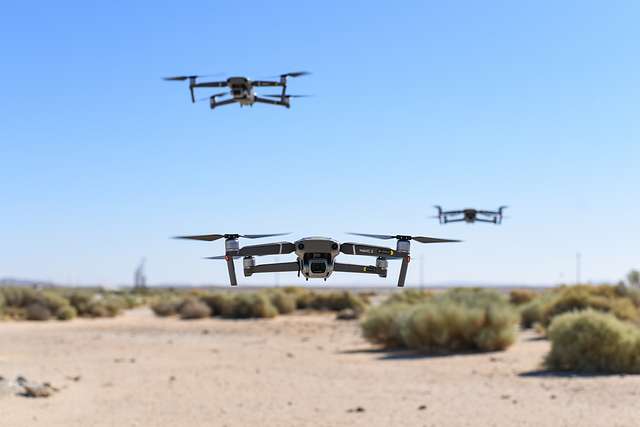Challenge to allow start-ups to show off counter-UAS tech
By DRONELIFE Features Editor Jim Magill
Entrepreneurs hoping to develop the next big thing in counter-UAS technology will get an opportunity to show their stuff as part of the Proven in Pendleton Challenge, hosted by the Oregon UAS Accelerator this spring.
The Challenge will offer more than $120,000 in prize money awarded to the developers of the most innovative counter-drone technologies. In addition, all event finalists will receive one month of free flight testing at the Pendleton UAS Test Range.
Finalists will vie with one another, with the competition culminating at the AUVSI Spring Symposium in Pendleton, Oregon to be held April 24 and 25. There the finalists will demonstrate their innovations and pitch to a panel of judges to see who walks away the “Proven in Pendleton c-UAS Champion” award. The first-place innovator will also receive a $100,000 non-dilutive grant, while the second-place innovator receives a $20,000 non-dilutive grant.
“It’s going to be exciting,” Chris Ponzillo, the Oregon UAS Accelerator’s chief marketing officer said in an interview. “The goal here is to get innovators in front of the industry.”
The Oregon UAS Accelerator, based at the Eastern Oregon Regional Airport and Pendleton UAS Test Range, serves as a springboard for UAS startup companies, helping them to rapidly develop and commercialize their technologies.
Ponzillo said the Accelerator’s goal is to roll out a different Challenge, each one focusing on one aspect of the UAS industry, once a year or twice a year. The theme of the current challenge was chosen in response to the heightened awareness over suspected improper drone activity and the industry’s increased focus on the need for developing counter-drone solutions.
The Counter-UAS Technology Competition
“We’ve had a ton of drone incursions now,” he said. He cited the recent spike in the number of alleged drone sightings in the skies over New Jersey, and said that while those reports have largely been dismissed as not being the result of hostile actors operating drones, there remains a credible threat of unwelcome drone incursions over political gatherings, jails and prisons, and military sites.
“Eighty-four percent of NATO forward bases have had some type of drone incursion in the last year or two,” Ponzillo said. “So, it’s a problem in the industry.”
The Accelerator will be taking applications through mid-March. Applicants will be reviewed to determine if their companies fit the requirements of the challenge. The Challenge’s focus will be on the development and deployment of technologies that can detect, track and neutralize drone threats in diverse environments.
According to a press release, the Challenge “aims to foster innovations applicable to both commercial settings and defense scenarios, including:
● Urban security for stadiums, airports, and critical infrastructure;
● Military and law enforcement operations; and
● Private sector applications for corporate and event security.
By focusing on dual-use innovations, we aim to identify versatile c-UAS technologies that can address the complex drone threat landscape across multiple domains.”
All applicants will submit to a virtual pitch session that will be judged, and the top five finalists selected from that session, will be flown to Pendleton, where the Accelerator will put them up for a few days in preparation for the Challenge’s final judging, Ponzillo said.
“The first day they’re going to be with just us on the range and demonstrating that their technology really does what they say it can do. And then the next day we will put them up on the stage at AUVSI, where they will pitch from an audience to a judge that will grade them as to feasibility and marketability, and the winners will be selected right then and there,” he said.
Matching innovators with investors
The Oregon UAS Accelerator was started last year as one of Oregon’s five centers of innovation excellence. It is located at the Pendleton UAS Test Range in northeast Oregon, one of the largest such ranges in the country, supporting nearly 50,000 UAS operations since its inception.
The range’s approved FAA Certificates of Authorization (COA) allow for large and small drone operations over a 14,000-square-mile area, featuring more than 50 diverse microclimate environments. The hangar in which the Accelerator is house is the former home of Doolittle’s Raiders of World War II fame.
Ponzillo said the Accelerator is in the process of onboarding its second cohort of startups, comprising five to seven fledgling UAS companies at a time. “Every cohort ends in an investor event. We take on both civilian and defense or military-type innovators,” he said.
Four members of the Accelerator’s initial cohort have received investment or partnership opportunities.
One of the member companies has secured a contract involving counter-UAS trial monitoring for the Oregon prison system. Another cohort member, a military technology company “has gone dark,” he said. “So, we believe that is indicative of them having some type of partnership or agreement come into place where they can’t talk to us about it.”
Candidates for the Accelerator program must undergo a competitive selection including the completion of a comprehensive application, an artificial intelligence (AI) review of that application to make sure the candidate company is a good fit for the program, and consultations with the Accelerator’s business and technical mentors.
“And then a pitch and Q&A session with our selection committee,” Ponzillo said. Out of a typical candidate pool of from 30 to 50 companies, the application process whittles that number down to between five and seven cohort members.
Once accepted into the program, each new cohort member receives a total of $40,000 in non-dilutive grants, which helps fuel the start-up’s growth without it having to give up any equity. The new cohort member then spends 12 weeks with the Accelerator’s mentors on the test range.
“Each group will also go through a 12-week grant course, on how to find, how to apply for, and how to respond to grants. You have the technical mentoring sessions happening the whole time,” Ponzillo said. All the cohort members also go through 12 weeks of training in developing their business pitch with the Accelerator’s pitch team and graphic or visual specialists.
“Then we’re putting you in front of 30 investors, to pitch your idea,” Ponzillo said. “All that’s going on while the range team and our tech team is working with you hands-on at the test range — test flights, development, tweaking — to really not only have your product be an idea, but actually to be marketable and proven when we’re done.”
Companies can learn more about and apply for the Proven in Pendleton Challenge at oregonuas.org/challenge.
Want DRONELIFE news delivered to your inbox every weekday? Sign up here.
Read more:

 Jim Magill is a Houston-based writer with almost a quarter-century of experience covering technical and economic developments in the oil and gas industry. After retiring in December 2019 as a senior editor with S&P Global Platts, Jim began writing about emerging technologies, such as artificial intelligence, robots and drones, and the ways in which they’re contributing to our society. In addition to DroneLife, Jim is a contributor to Forbes.com and his work has appeared in the Houston Chronicle, U.S. News & World Report, and Unmanned Systems, a publication of the Association for Unmanned Vehicle Systems International.
Jim Magill is a Houston-based writer with almost a quarter-century of experience covering technical and economic developments in the oil and gas industry. After retiring in December 2019 as a senior editor with S&P Global Platts, Jim began writing about emerging technologies, such as artificial intelligence, robots and drones, and the ways in which they’re contributing to our society. In addition to DroneLife, Jim is a contributor to Forbes.com and his work has appeared in the Houston Chronicle, U.S. News & World Report, and Unmanned Systems, a publication of the Association for Unmanned Vehicle Systems International.


Miriam McNabb is the Editor-in-Chief of DRONELIFE and CEO of JobForDrones, a professional drone services marketplace, and a fascinated observer of the emerging drone industry and the regulatory environment for drones. Miriam has penned over 3,000 articles focused on the commercial drone space and is an international speaker and recognized figure in the industry. Miriam has a degree from the University of Chicago and over 20 years of experience in high tech sales and marketing for new technologies.
For drone industry consulting or writing, Email Miriam.
TWITTER:@spaldingbarker
Subscribe to DroneLife here.


